If you’re in the market for a new shower drain, you may be wondering which type is right for you. With different kinds of shower drains on the market, sometimes it can be difficult to decide which one is best for your needs.
Shower Drains have two major types, point drains, and linear drains. The point drains are further classified as one-piece, three-piece, and multi-piece drains based on their layer of components. Whereas, the linear drains are classified in terms of customizable and fixed length options.
This information seems inadequate for you, right? So, further, in this article, you will get to know the multiple types of shower drains. We will also compare them, and then you can decide which one’s best for you.
Two Main Types of Shower Drain
A shower drain is a plumbing fixture that is installed on the floor of a shower to remove water from the shower. The water is drained from the shower through a pipe leading to a drain in the sewer system.
Based on the shape and size of the drains, there are two main types of shower drains:
- Point Drain
- Linear Drain
The point drain has multiple sub-types which are explained in the later sections.
1. Point Drain and Its Sub-Types
A point drain is the most popular shower drain. It is usually located in the middle of the shower space. To install this type of drain, the floor is designed with a multi-directional slope that directs water from all sides into the point drain.
Point drains are tiny and cheap yet nonetheless effective at emptying any size shower. Some designs feature a square top, however, you will commonly see them round.
The corners of the drains contain little slopes that force the water to flow against the drain’s slope in specific directions. As a result, the shower space doesn’t overfill or flood.
Point Showers are not well suited for showers without a curb. Another downside is that you cannot use them with large tiles.
Overall, the point drains are inexpensive, easy to install, and available anywhere. Moreover, it is hardly observed a shower space drains slowly with point drains.
Now, speaking of sub-types, a point drain can be single-piece, three-piece or multi-piece.
Single Piece Drain
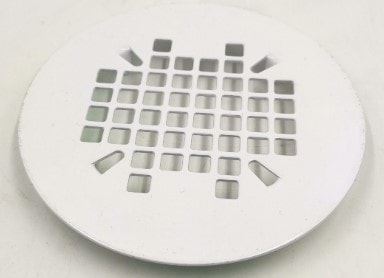
The simplest one of all point drains single-piece drain. It is designed for concrete floors that are tiled.
Single piece drain is quite easy to install as it has very few components. You just have to place it over the top of a drain pipe. Then, screw a strainer on top of it.
Three-Piece Drain
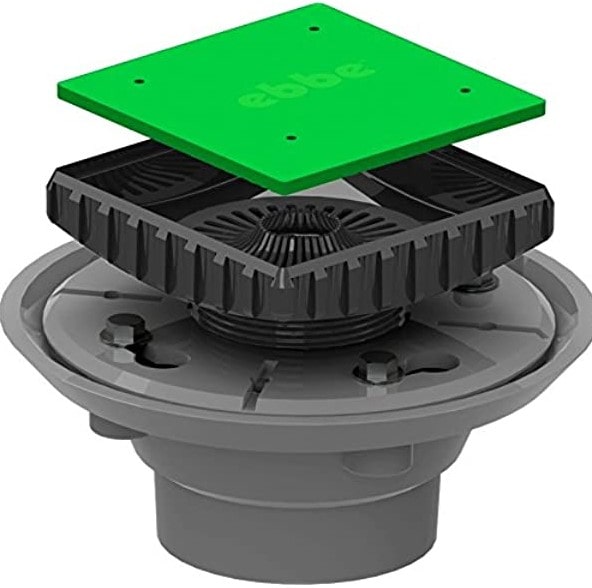
A three-piece drain, unlike a single-piece drain, is designed to protect the wooden floor beneath.
If the shower is likely to be installed on a wooden floor, or a shower pan, then it is a good option to choose a 3-piece drain. It will resist the buildup of mold or mildew over wood.
As its name suggests, it has three main components. The bottom piece is inserted directly into the drain pipe, the second piece is placed on the shower pan. The top piece is then screwed over the top of the tiles.
Multi-Piece Drain
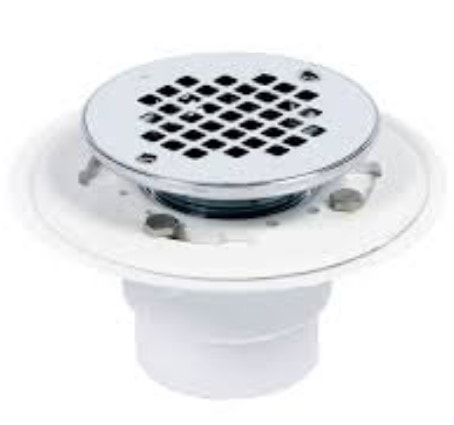
Multi-piece drains are composed of various layers of parts. From the top, the order of parts is usually: strainer, locking ring (brass), compression gasket (rubber), a threaded drain, and a gasket or washer.
These drains are used for both applications, concrete and wooden floors. And their installation is also simple. The strain is screwed from the top, while the other parts sit in the drain pipe.
2. Linear Drain and its Types
As their name indicates, the drains are linear. They are in the form of long rectangular strips, which can be as long as 72 inches.
Normally, you will find them installed near the boundary wall, and the slope is inclined towards them. However, there is no compulsion to install them in the middle.
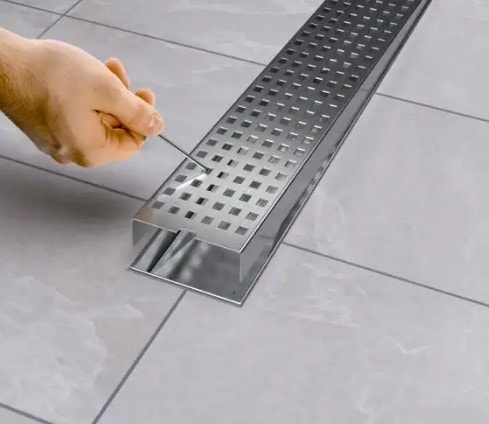
Since the linear drains are very large, you will have no problem installing them with larger tiles. In addition, they make a great combination with the curbless shower. The water would easily drain from the long linear grate rather than entering the bathroom space.
The linear drains have been gaining popularity over the years due to their unique style. They give your bathroom a more modern and stylish look. However, this quality makes them rare and expensive.
Speaking of their types, there are two, one whose length can be customized, while the other has a fixed length.
Customizable Linear Drains
Customizable linear drains are the ones that can be cut based on the dimensions of the site. I mean you can purchase a larger, and then cut it based on your shower space.
Fixed Length Linear Drains
The fixed-length linear drains come in fixed standard size. You can’t reduce them based on your needs. So, if you have a customized shower space the fixed linear drains won’t be of any help.
Tileable Drain Grate / Invisible Drain
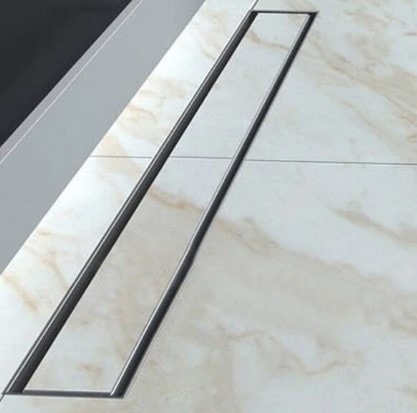
The tileable drain grates are linear drains, which come with a tile insert. These are very helpful if you want to blend your drain into the shower floor.
In this case, you use a tile of the same color as the floor and install it on the top of the grate. The water drains from the space around the tile’s edge. In this way, the drain blends into your shower floor, however, since the drain opening is small, the water drains off slowly.
Which Drain Should You Choose? Linear vs. Point Drain
Since we have covered multiple types, still it must have been hard for you to decide which is better for you. So, let’s compare these two drain types.
Design
In terms of design and looks, the linear drains are ahead of the point drains. You will find multiple colors, shapes, and designs in the linear grate category.
Space and Ease of Installation
For small shower spaces, point drains are an excellent choice to consider. Similarly, due to their simplistic design point drains are much easier to install when compared with their counterpart.
Tile Usage
Point Drains are more compatible with small tile sizes. Whereas, the linear drain easily fits in with large tiles.
Moreover, when you install a point drain, you will have to create a multi-directional gradient in the floor. While for linear drain, the unidirectional gradient is sufficient.
Maintenance
The maintenance is relatively easier for linear drains since they do have a debris collection basket, which can be removed, cleaned, and reinstalled.
Cost
Point drains are very common and popular. That’s why there will be within your budget. You can expect to get them for under $50. Whereas, the linear drains usually cost more than $200.
So, these were some of the essential factors which you must consider before deciding. If you ask me, then I would prefer linear drains for their design and compatibility with large tiles. But it’s ultimately your call to make.
FAQs
Here are some of the frequently asked questions related to shower drains.
What is a shower grate?
The shower grate is another name for the linear shower drain. They are metallic trays and are available in different lengths and sizes.
How much do linear drains cost?
Linear drains are more expensive than traditional point drains, costing more than $200 on average.
What should be the slope for installing drains
As per the plumbing codes, there should be a minimum slope of ¼ inch per foot to make sure the water slides easily to the drain opening.
Wrap Up
To sum it up, I would state that the linear drains are more expensive but offer a stylish look. Point drains are less expensive and easier to install but may not be as stylish. Ultimately, the decision comes down to budget and personal preference.
I hope this guide helped you understand the different types of shower drains available in the market. If you have any questions, let us know in the comments section.

Amos Christen graduated with a bachelor’s degree in Interior Design from Drexel University — Philadelphia, PA. Since 2003, Amos has worked with top interior design professionals in this area, including architects and interior/graphic/lighting designers. As a skilled interior designer, Amos Christen is highly versed in fine arts and crafts and uses that to supplement his main area of expertise. He often publishes articles related to home décor on several websites, including Sprucetoilets.com, Sprucebathroom.com, and Mybesuitedhome.com. He also contributes to leading interior design magazines.